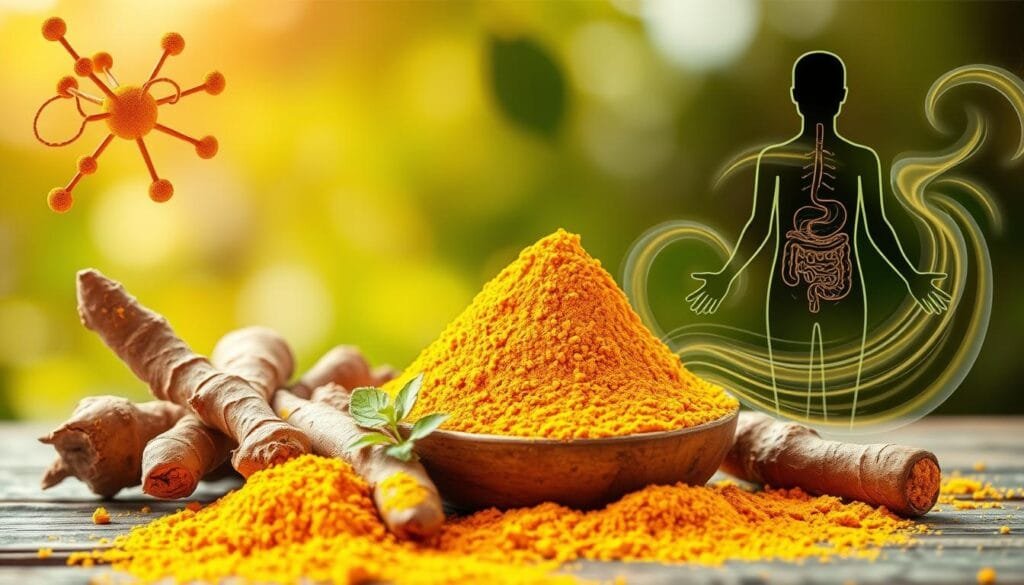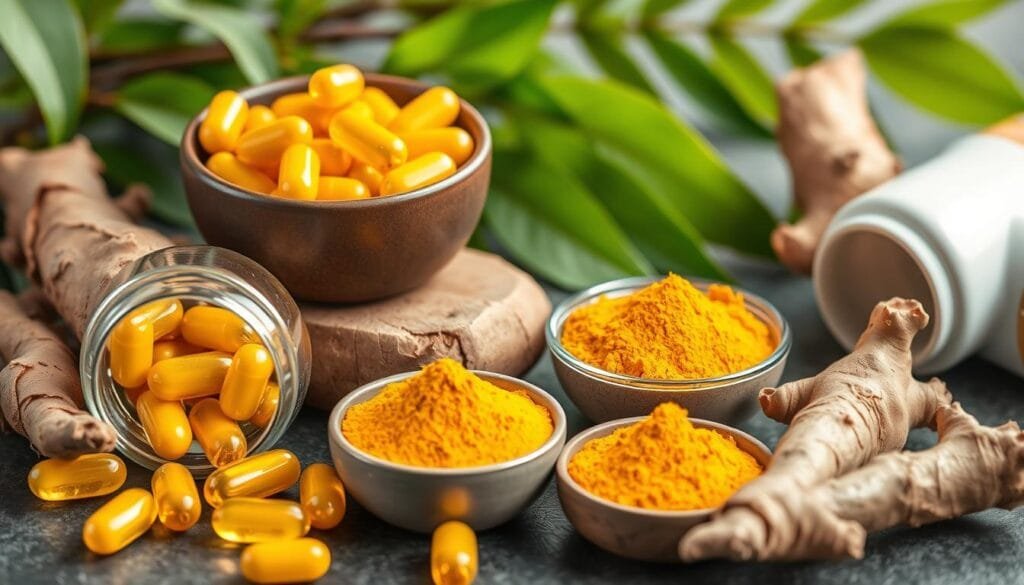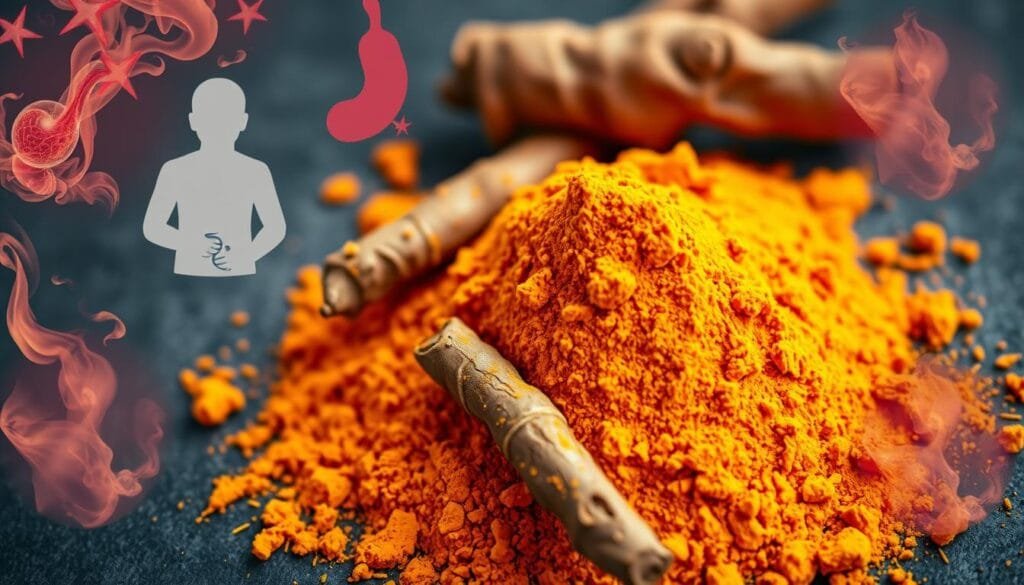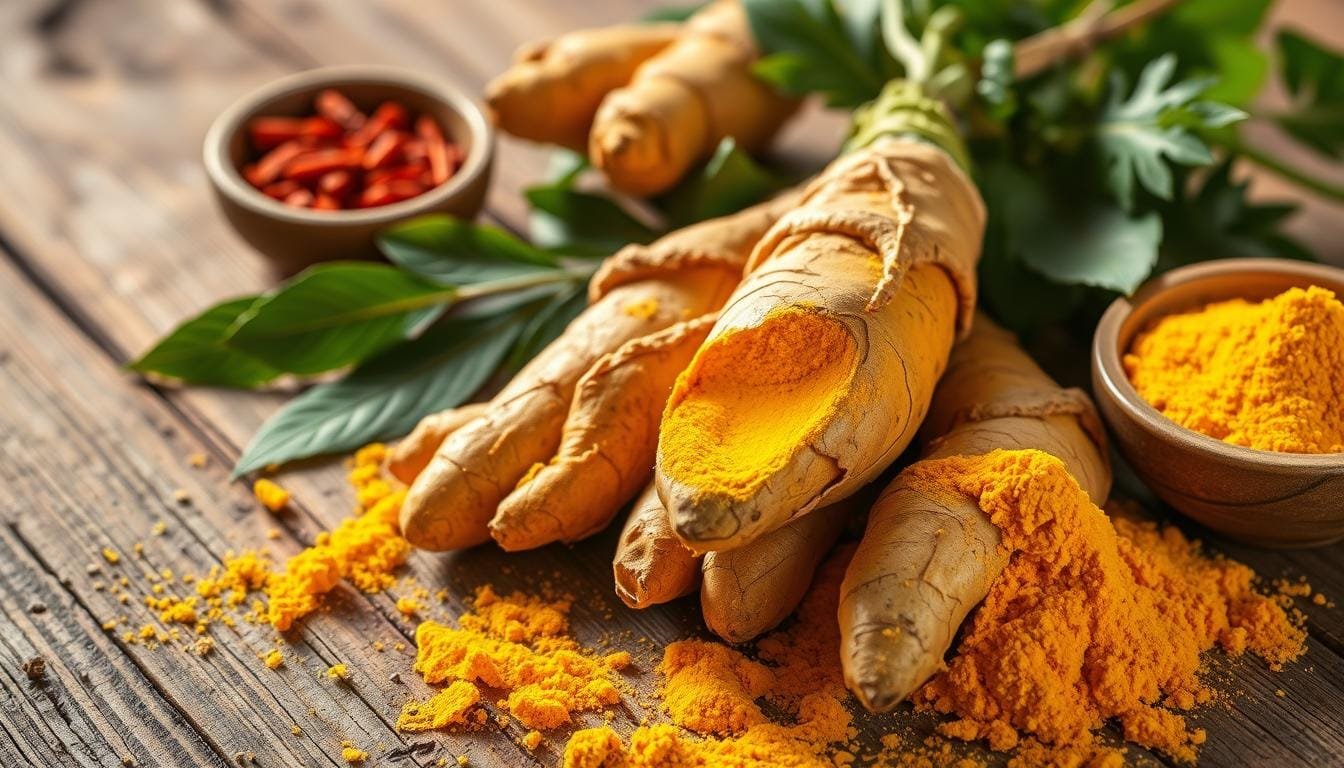Turmeric, a golden-orange spice, is closely related to ginger. It has been used in traditional medicine and cooking for centuries. At its core is curcumin, a natural compound with strong antioxidant and anti-inflammatory effects. This spice could help with various inflammatory conditions, making it a good alternative to regular pain meds.
Curcumin, turmeric’s key ingredient, has been studied a lot for its anti-inflammatory powers. It targets the source of pain and discomfort. This could help with arthritis, joint pain, irritable bowel syndrome, and heartburn. While more research is needed, the current evidence shows turmeric could be a good addition to your diet for managing inflammation and improving health.
Adding turmeric to your diet, through supplements or creative meals, can be a big step towards better health and pain control. By using curcumin, you might find relief without the side effects of traditional pain meds.
Understanding Turmeric’s Anti-Inflammatory Properties
Turmeric, a bright yellow spice, is famous for its anti-inflammatory powers. It’s packed with curcumin, a compound that scientists love to study. This spice is a big deal in Asian cooking.
The Science Behind Curcumin
Curcumin is the star of turmeric. It fights off free radicals and reduces inflammation. It works by controlling enzymes and pathways that cause inflammation.
How Inflammation Affects the Body
Inflammation is linked to many health problems. It can cause pain, fatigue, and even serious diseases. Turmeric might help prevent or manage these issues.
Active Compounds in Turmeric
Turmeric is full of good stuff, with curcumin being the most studied. But it also has other compounds that help its health benefits.
| Turmeric Compound | Percentage in Turmeric | Key Benefits |
|---|---|---|
| Curcumin | 5-6.6% | Powerful antioxidant and anti-inflammatory properties |
| Demethoxycurcumin | 2-6% | Potent antioxidant and anti-inflammatory effects |
| Volatile Oils | up to 3.5% | Contribute to the aroma and flavor of turmeric |
For 25 years, scientists have been studying turmeric. They’re excited about its curcumin and its anti-inflammatory mechanisms. It could have many health benefits.
The Historical Use of Turmeric in Traditional Medicine
Turmeric, the vibrant golden spice, has a rich history in traditional medicine. It comes from the Curcuma longa plant. For centuries, it’s been key in ayurvedic medicine in India and traditional Chinese medicine.
The Curcuma genus has about 120 species, with Curcuma longa being the most famous. The active part, curcumin, was first found in 1815. It was fully described as a pure crystal in 1870. The EU recognizes curcumin as a food additive, showing its wide acceptance.
Turmeric’s importance is shown by ayurvedic literature with over 100 terms for it. In ancient times, it was used for its anti-inflammatory effects. Its essential oil was also used in perfumes.
Today, turmeric is loved in traditional healing practices in Asia. The World Health Organization says 75% of the world uses herbs for health. Its uses in food and medicine have made it a global wellness staple.
Turmeric is known for its anti-inflammatory and antioxidant properties. It’s recognized for helping with many health issues. Its use in ayurvedic medicine and traditional Chinese medicine has led to modern research. This research aims to understand turmeric’s full benefits for health.
Using Turmeric for Inflammation: Evidence-Based Benefits
Research shows turmeric and its active part, curcumin, have anti-inflammatory effects. Many studies have looked into its benefits for different inflammatory conditions.
Clinical Studies and Research Findings
A study with 80 osteoarthritis patients showed a daily dose of 80 mg of curcumin nano-micelle improved inflammation markers. These markers are CRP and TNF.
Another study tested curcumin doses of 1, 5, and 10μM on LPS-induced BV2 cells. It found curcumin reduced inflammation and promoted an anti-inflammatory response.
Recommended Dosage for Pain Relief
While research is promising, there’s no agreed-upon dosage for turmeric or curcumin. Some studies suggest 500 milligrams to 1.4 grams per day for conditions like osteoarthritis. But, more research is needed for specific dosages.

The curcumin in turmeric is usually 1-6% by weight. Studies use extracts with over 1 gram of curcumin per day. To get enough curcumin, try turmeric with black pepper or a high-fat meal.
How Turmeric Fights Different Types of Pain
Turmeric, a bright yellow spice from the Curcuma longa plant, is known for its anti-inflammatory effects and pain management abilities. Its main compound, curcumin, has been studied a lot. Researchers are looking into how it can help with different kinds of pain.
Turmeric might help with arthritis pain. A 2016 study looked at six studies on turmeric or curcumin for arthritis pain. They compared it to a placebo, glucosamine, and NSAIDs like ibuprofen or diclofenac. The curcumin doses ranged from 100 milligrams to 2000 milligrams daily.
The studies showed curcumin reduced pain a lot compared to the placebo. It was as good as ibuprofen and diclofenac in easing pain and stiffness.
Turmeric’s anti-inflammatory properties might also help with joint discomfort and muscle soreness. While everyone reacts differently, the evidence suggests turmeric could be a good natural pain relief choice for those looking for alternatives to traditional pain meds.
“The studies found that curcumin decreased pain significantly compared to placebo and was comparable to ibuprofen and diclofenac in decreasing pain and stiffness.”
But, we need more research to really understand how turmeric fights pain. We also need to look into its long-term effects and any possible side effects of using it for pain management.
Bioavailability: Maximizing Turmeric Absorption
Getting the most out of turmeric’s anti-inflammatory powers depends on bioavailability. Curcumin, turmeric’s key compound, is hard for our bodies to absorb. But, there are ways to boost its absorption and unlock turmeric’s full benefits.
The Black Pepper Connection
Adding black pepper to turmeric is a smart move. Piperine in black pepper makes curcumin 2000% more absorbable. This combo is a game-changer, helping your body use turmeric’s anti-inflammatory effects better.
Fat-Soluble Properties
Turmeric works best with fats, not water. Mixing it with healthy fats like coconut oil, avocado, or olive oil boosts its absorption. This simple trick can make turmeric supplements or recipes much more effective.
Using these tips can help you get the most out of turmeric. Adding black pepper and healthy fats to your turmeric dishes or supplements can greatly improve your health and wellness.

“Curcumin, the active compound in turmeric, has over 6,000 citations associated with activities such as antioxidant, anti-inflammatory, anticancer, antiviral, and antibacterial properties.”
Common Conditions Treated with Turmeric
Turmeric is a bright yellow spice known for its health benefits. It has a rich, earthy flavor. This plant has been studied a lot, showing it can help with many health issues.
Turmeric is great at fighting inflammation. The part of turmeric called curcumin works as well as some medicines for osteoarthritis. It also helps with digestive issues like irritable bowel syndrome (IBS) by soothing the gut.
Turmeric is also good for the skin. It can reduce blemishes, help wounds heal, and treat some skin problems. This is because of its anti-inflammatory properties.
Research on turmeric for Alzheimer’s disease and certain types of cancer is just starting. But the early results are encouraging. As scientists learn more, turmeric could be a natural solution for many health problems.
| Condition | Key Findings |
|---|---|
| Osteoarthritis | Research suggests that turmeric extract may reduce pain from osteoarthritis. |
| Irritable Bowel Syndrome (IBS) | In a study of patients with ulcerative colitis, those who took 2 grams of curcumin a day along with prescription medication were more likely to stay in remission compared to those who took the medicine alone. |
| Skin Conditions | Turmeric’s anti-inflammatory properties may help reduce the appearance of blemishes and promote wound healing. |
| Alzheimer’s Disease | 90 milligrams of curcumin taken twice a day for 18 months improved memory performance in adults without dementia. |
| Cancer | A study showed a 40% reduction in the number of lesions in the colon in men with colorectal cancer when using curcumin. |
While turmeric looks promising, more research is needed. Always talk to a doctor before adding turmeric to your routine.
Different Forms of Turmeric Supplements
Turmeric, the vibrant yellow spice, is popular for its natural anti-inflammatory and pain-relieving effects. It’s found in whole foods, but supplements offer a more concentrated dose. This is great for those looking for specific health benefits.
Pills and Capsules
Turmeric supplements often come as pills or capsules. They contain concentrated curcumin extracts. These supplements give you more of the active compounds than food does.
A study of 15 trials showed that curcumin supplements help with pain and function in osteoarthritis. They often work better than common pain medicines.
Powders and Teas
Turmeric can also be taken as a powder. It can be used alone or mixed into drinks like golden milk or turmeric tea. Ground turmeric has only 2-6% curcumin, but its other compounds may work together well.
Drinking turmeric tea is a nice way to enjoy its anti-inflammatory benefits. It’s warm and comforting.
The way turmeric supplements are absorbed can vary. Some have black pepper to help with curcumin absorption. Always choose high-quality, third-party tested products for the best results.

“Turmeric has been found to reduce pain and improve function for osteoarthritis as effectively as some painkillers.”
Safety Considerations and Possible Side Effects
Turmeric has been safe in food for centuries. But, taking too much turmeric in supplement form can cause problems. It’s important to know these risks before adding turmeric to your routine.
Digestive Issues: Some people might get mild stomach problems like nausea, pain, or diarrhea from turmeric supplements. This usually happens because of the high curcumin levels.
Allergic Reactions: Rarely, some might have an allergic reaction to turmeric or curcumin. This can show as itchiness, hives, or swelling, and in serious cases, anaphylaxis. If you experience any of these, seek medical help right away.
Liver Concerns: There are reports of liver problems from taking too much turmeric. Always talk to a doctor before starting turmeric, if you have liver issues or are on medications that could interact with it.
| Potential Side Effects of Turmeric Supplements | Possible Causes |
|---|---|
| Digestive Issues (nausea, abdominal pain, diarrhea) | High concentration of curcumin |
| Allergic Reactions (itchiness, hives, swelling) | Sensitivity to turmeric or curcumin |
| Liver Injury or Toxicity | Excessive consumption of turmeric supplements |
| Decreased Iron Absorption | Curcumin’s ability to bind to iron |
| Hypoglycemia (low blood sugar) | Turmeric’s ability to lower blood glucose levels |
Turmeric might also affect how certain medicines work. This includes blood thinners, antidepressants, and chemotherapy drugs. Always check with a doctor before starting turmeric supplements, if you’re on any medications or have health issues.
To make sure your turmeric supplements are safe and good quality, look for the USDA or third-party certifications like NSF International, Informed Choice, or the U.S. Pharmacopeial Convention (USP). Being informed and cautious can help you enjoy turmeric’s benefits while avoiding side effects.

Incorporating Turmeric Into Your Daily Diet
Turmeric is a versatile spice that can easily be added to your daily meals. It’s not just for curries. This vibrant yellow root can add flavor and health benefits to soups, stews, smoothies, and teas.
Cooking Methods and Recipes
When cooking with turmeric, a little goes a long way. Just a pinch or up to a tablespoon can add a warm, earthy flavor. It pairs well with vegetables like cauliflower, potatoes, and root vegetables, as well as in rice and grain-based meals.
To make turmeric’s benefits better, mix it with black pepper and healthy fats like avocado, nuts, or oils. This trick helps your body use turmeric’s anti-inflammatory properties better.
Turmeric’s vibrant color is great in smoothies, soups, and baked goods. Try making turmeric-infused recipes to find new ways to enjoy this superfood.
Golden Milk and Other Beverages
Golden milk is a popular way to enjoy turmeric. It’s made with turmeric, milk (dairy or plant-based), cinnamon, ginger, and black pepper. This warm drink is comforting.
Turmeric can also be made into teas or added to juices and smoothies. Its earthy flavor goes well with many fruits and vegetables. It’s a great choice for health-conscious drinks.
Adding turmeric to your daily diet is easy and tasty. You can cook with it, drink it in a warm beverage, or blend it into a smoothie. Turmeric is a valuable addition to your health and wellness routine.
Drug Interactions and Precautions
Turmeric is known for its anti-inflammatory and pain-relieving effects. But, it’s important to know the risks of taking turmeric supplements, mainly if you’re on medication. Turmeric’s active compound, curcumin, can interact with some drugs and cause side effects.
One major concern is turmeric’s interaction with blood-thinning drugs like Coumadin (warfarin) and Plavix (clopidogrel). It can increase the risk of bleeding. So, if you’re taking these medications, talk to your doctor before using turmeric.
Turmeric might also affect diabetes medications, changing blood sugar levels. People with diabetes should watch their blood sugar closely and talk to their doctor about using turmeric.
Those with gallbladder issues, bleeding disorders, or anemia should avoid turmeric. Pregnant women and those planning surgery should also not take turmeric supplements due to bleeding risks.
Side effects of turmeric include nausea, stomach pain, and rare esophageal damage. The World Health Organization suggests a daily curcumin intake of 1.4 milligrams per pound of body weight. Most supplements recommend 500 milligrams a day.
Before adding turmeric to your routine, talk to your healthcare provider. This is important if you’re on medication or have health conditions. Knowing about turmeric drug interactions, medication precautions, and health risks helps you use turmeric safely and get its benefits.
Natural Anti-Inflammatory Alternatives to Turmeric
Turmeric is well-known for its anti-inflammatory effects. But, there are other natural options I can try. Ginger, for example, has similar benefits. Omega-3 fatty acids in fatty fish like salmon or tuna are also effective.
Green tea and fruits like berries and cherries contain compounds that fight inflammation. Herbal remedies like boswellia and bromelain from pineapples also show promise. Eating a variety of colorful fruits and vegetables can add to my health.
Before trying these alternatives, I should talk to a healthcare provider. Everyone reacts differently, and it’s key to make sure these options are right for me. By exploring these natural solutions, I can find safe and effective ways to manage inflammation and discomfort.
FAQ
What are the key active compounds in turmeric?
How does turmeric help reduce inflammation in the body?
What is the history of turmeric in traditional medicine?
What are some of the evidence-based benefits of turmeric for inflammation and pain?
How can I maximize the absorption of turmeric in my body?
What are some common conditions treated with turmeric?
What are the different forms of turmeric supplements?
Are there any side effects or safety concerns with taking turmeric?
How can I incorporate turmeric into my daily diet?
Are there any interactions between turmeric and medications?
What are some other natural anti-inflammatory alternatives to turmeric?
Source Links
- https://www.unitypoint.org/news-and-articles/using-turmeric-as-anti-inflammatory
- https://www.webmd.com/vitamins/ai/ingredientmono-662/turmeric
- https://www.ncbi.nlm.nih.gov/books/NBK92752/
- https://www.arthritis.org/health-wellness/healthy-living/nutrition/anti-inflammatory/turmeric-wont-help-arthritis
- https://www.health.com/turmeric-benefits-8674914
- https://pmc.ncbi.nlm.nih.gov/articles/PMC7522354/
- https://www.phytojournal.com/archives/2019/vol8issue1/PartAT/8-2-135-332.pdf
- https://www.healthline.com/nutrition/top-10-evidence-based-health-benefits-of-turmeric
- https://pmc.ncbi.nlm.nih.gov/articles/PMC8572027/
- https://www.uclahealth.org/news/article/ask-the-doctors-can-turmeric-reduce-inflammation
- https://www.mountsinai.org/health-library/herb/turmeric
- https://www.webmd.com/diet/supplement-guide-turmeric
- https://pmc.ncbi.nlm.nih.gov/articles/PMC3918523/
- https://pmc.ncbi.nlm.nih.gov/articles/PMC8540263/
- https://health.clevelandclinic.org/turmeric-health-benefits
- https://www.healthline.com/nutrition/turmeric-dosage
- https://www.cvs.com/shop/vitamins/herbals/turmeric
- https://www.healthline.com/nutrition/turmeric-side-effects
- https://www.medicalnewstoday.com/articles/318405
- https://www.verywellhealth.com/10-serious-side-effects-of-turmeric-8703958
- https://www.thekitchn.com/7-ways-to-eat-drink-turmeric-198696
- https://www.naturemade.com/blogs/health-articles/15-ways-to-eat-turmeric-improve-your-diet
- https://www.medicinenet.com/which_medications_not_to_take_with_turmeric/article.htm
- https://www.rxlist.com/turmeric_curcumin/generic-drug.htm
- https://www.healthline.com/health/osteoarthritis/turmeric-and-anti-inflammatory-herbs
- https://www.medicalnewstoday.com/articles/326067







